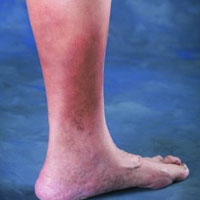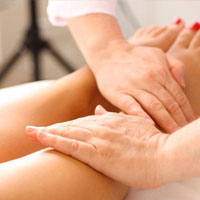Veins are the body’s drainage system to bring blood back to the heart and lungs. Our veins contain valves to keep blood flowing in one direction, but with Chronic Venous Insufficiency (CVI) your valves can become leaky and lead to blood flowing in the wrong direction and pooling in your lower legs.
Common Leg Symptoms of CVI include:
Common Risk Factors for CVI include:
CVI can sometimes be seen on the surface in the form of varicose and spider veins, but in some patients, it can only be seen on an ultrasound. Various problems our patients suffer from are:

Spider veins are small, dilated vessels on the surface of the skin and commonly signal a deeper root cause of chronic venous insufficiency (CVI). These spider veins can be indirectly treated by performing procedures that treat CVI and eliminate the root cause. We also offer cosmetic visual sclerotherapy for the treatment of spider veins. It is recommended to hold off this treatment for 4 weeks after CVI is treated in order to get the best visual results.

Varicose veins are large, bulging veins that are visible on the surface of the legs. Besides being visually unappealing, these vessels can cause itching, pain, and can eventually cause bleeding and ulcerations if left untreated. These veins are the result of increased pressure from blood pooling in the lower extremities. Varicose veins are easily treatable with in office procedures and can dramatically improve both your symptoms as well as the appearance of your legs.

Edema, or swelling, is a very common condition and can occur for a variety of reasons. Edema commonly occurs in the lower legs, ankles, and feet. It can affect one leg or both and worsen as the day goes on. At our clinic, we can evaluate you for the cause of your edema, provide treatment options, and referrals if necessary.

In more advanced cases of CVI, the skin on the inner aspects of the lower legs can change, becoming darker and thicker than normal. This is called “Hyperpigmentation” or “Venous Stasis Dermatitis.” This is due to long standing inflammation in that tissue, which is directly related to the patient’s venous issues. This inflamed tissue is more prone to infections and ulcerations. Once a patient has developed hyperpigmentation, the skin changes are likely to be permanent, but treatment of the underlying venous issues can still be beneficial in making the tissue healthier and more resistant to infections and ulceration formation.

The most severe cases of CVI result in the formation of Venous Leg Ulcers. These ulcers typically form in the inner aspect of the lower legs, and are usually associated with hyperpigmentation in those areas. They can be extremely painful and slow to heal, many requiring the expertise of a wound care specialist to completely heal. In extreme cases, venous ulcerations can eventually lead to limb amputation. Treatment of the underlying venous issues plays a big part in getting these ulcers to heal, and in decreasing the likelihood of future ulcer formation. Obviously, one of the benefits of treating less advanced CVI is the prevention of ulcer formation in the first place.
Other Related Conditions

The lymphatic system consists of lymph nodes, lymphatic vessels, and lymphatic fluid and is part of the body’s natural immune system. Lymphedema is swelling that occurs due to lymphatic system dysfunction. Common causes include infection, lymph node resection during cancer treatment or damage to the lymphatic system from trauma, infection or surgery.

Phlebolymphedema is a common, but often overlooked condition in which a patient has swelling due to the combination of Chronic Venous Insufficiency and lymphedema. The high venous pressure from Chronic Venous Insufficiency (CVI) causes the body to create an increased amount of lymphatic fluid. The lymphatic system’s job is to collect and transport that fluid. In phlebolymphedema, the lymphatic system becomes overwhelmed by the increased volume of lymphatic fluid needing to be drained, and that fluid begins to accumulate in the tissue, causing swelling. This condition is often chronic, and can be debilitating, but can be managed with a combination of CVI treatment by a vein specialist and evaluation and treatment by a lymphedema therapist.

Lipedema is a chronic condition characterized by the abnormal accumulation of fat cells in the legs, thighs, buttocks, and sometimes the arms. It is more common in women and can occur at any age. Lipedema is often misdiagnosed as obesity or lymphedema, but it is a distinct disorder that can cause significant emotional and physical distress. Symptoms include pain, swelling and “cottage cheese” appearance of the skin. Patients with lipedema can also have Chronic Venous Insufficiency (CVI) and lymphedema. Treatment options include lifestyle changes, compression therapy and surgical intervention.

Restless Leg Syndrome (RLS) is characterized by a frequent, nearly irresistible urge to move the legs. It is typically more prominent with prolonged sitting or standing, and usually gets progressively worse throughout the day. The cause of RLS is poorly understood, and it is thought to be multifactorial. However, multiple studies have demonstrated a link between RLS and venous insufficiency, and in those cases, treatment of the underlying venous issues can improve or even resolve the RLS symptoms.
In most cases, health insurance and Medicare will cover treatment of vein procedures, assuming the patient meets the criteria for treatment. Out of pocket expense depends on many factors, such as deductible met and the specifics of the individual plan. Our staff will work with you to understand the benefits and coverage provided by your insurance as well as any requirements that will need to be met.






















